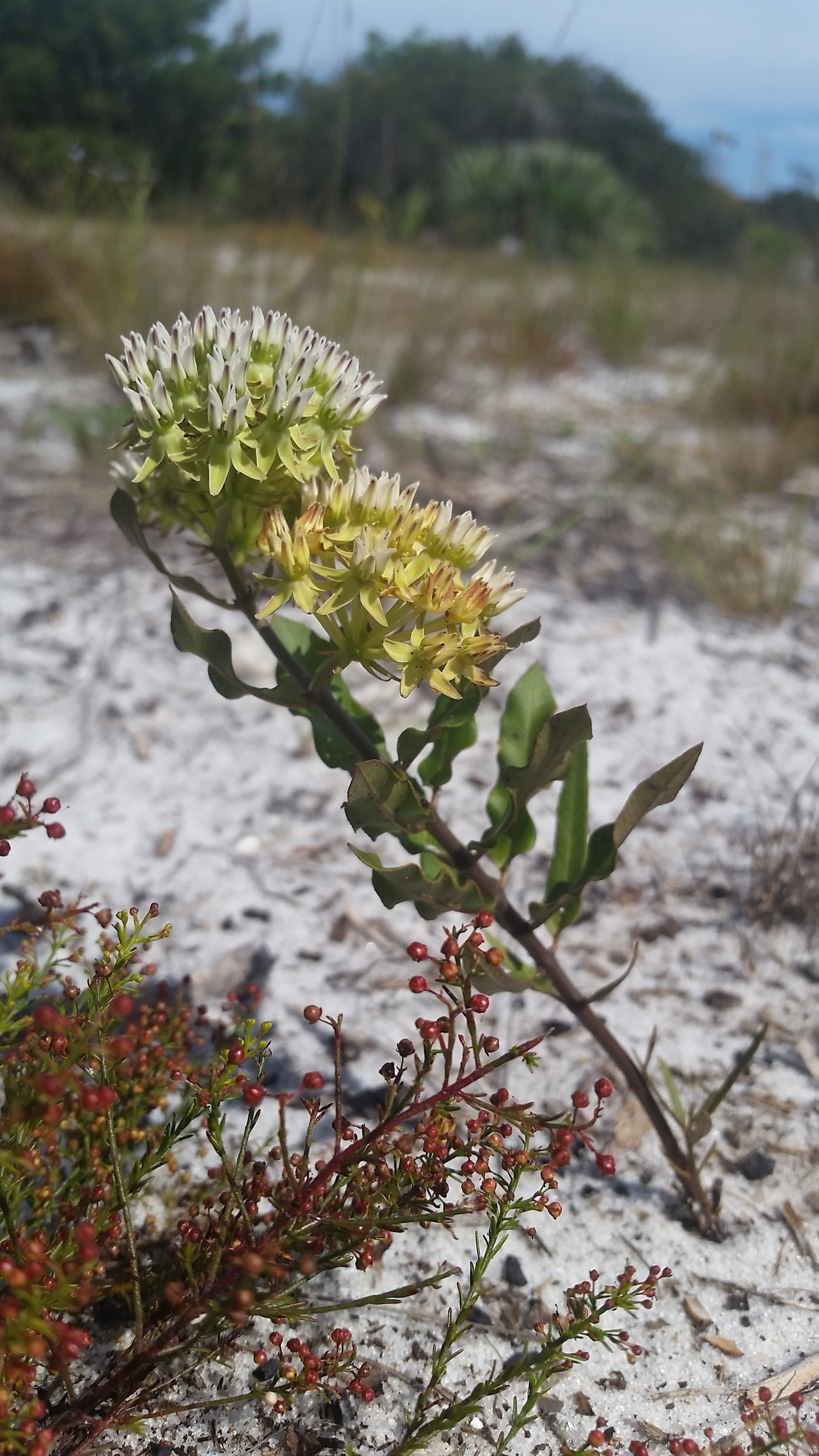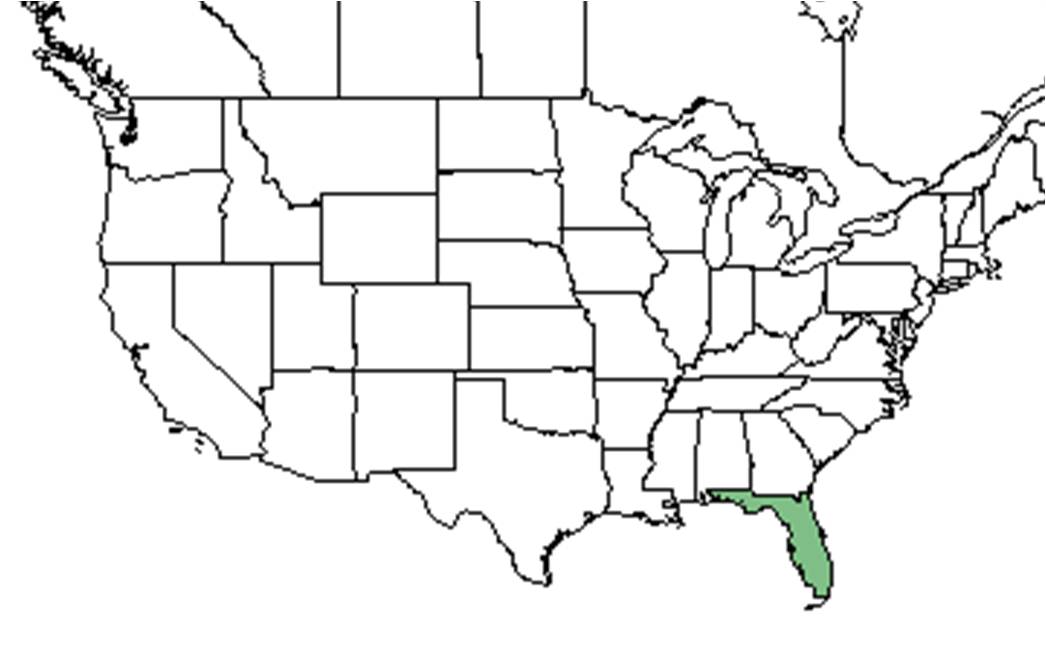Asclepias curtissii
| Asclepias curtissii | |
|---|---|

| |
| Photo taken by Michelle M. Smith | |
| Scientific classification | |
| Kingdom: | Plantae |
| Division: | Magnoliophyta - Flowering plants |
| Class: | Magnoliopsida - Dicotyledons |
| Order: | Gentianales |
| Family: | Asclepiadaceae |
| Genus: | Asclepias |
| Species: | A. curtissii |
| Binomial name | |
| Asclepias curtissii A. Gray | |

| |
| Natural range of Asclepias curtissii from USDA NRCS Plants Database. | |
Common name: Curtiss' milkweed
Contents
Taxonomic notes
Asclepias is named for Asklepio, the Greek god of medicine and healing.[1]
Synonym: Oxypteryx curtissii (A. Gray) Small.[2]
Varieties: none.[2]
Description
In general, with the Asclepias genus, these plants are perennial herbs containing milky sap. The stems are erect, spreading or decumbent and usually are simple and often solitary. The leaves are opposite to subopposite, are sometimes whorled, and rarely alternate. The corolla lobes are reflexed and are rarely erect or spreading. The filaments are elaborate five hoods forming a corona around the gynosteguim. The corona horns are present in most species.[3]
Asclepias curtissii, specifically, is a long-lived perennial that dies back in the fall and resprouts in the spring from an underground taproot (Mondo et al. 2010). Leaves are opposite and glaborous, with flowers arranged in dome-shaped umbels (Putz and Minno 1995).
Distribution
A. curtissii is an endangered perennial that is endemic to the Florida scrub in the central and southern peninsula[4] (Mondo et al. 2010).
Ecology
Habitat
In the Coastal Plain in Florida, A. curtissii can be found in scrubs[5][6][4] with Quercus myrtifolia, Q. chapmanii, Lyonia, Ilex, Selaginella, Lechea, pines and palmettos.[5] It has also been found in recently bulldozed low ancient scrub. It has been observed to be concentrated along roadsides seven times more often than in surrounding undisturbed habitat (Putz and Minno 1995). A. curtissii exhibits no significant response to soil disturbance by clearcutting, bracke seeding, single roller chopping, broadcast seeding, high-severity burn, and salvage logging in Central Florida.[7]
Phenology
Asclepias curtissii has been observed to flower from May to August, with most flowering in August.[8] Michelle Smith observed Asclepias curtissii flowering August 2015 at the Jupiter Inlet Lighthouse Outstanding Natural Area (Nature Preserve) in Tequesta (Palm Beach County), FL.
Seed bank and germination
It has been observed to grow in close proximity to woody vegetation and unlikely to be found in open gaps due to seed germination being enhanced by shade and not leaf litter (Mondo et al. 2010). Seeds planted in shaded areas among other shrubs have a higher rate of germination compared to seeds planted in open gaps (Mondo et al. 2010).
Fire ecology
The Nature Preserve in which Michelle Smith observed this species flowering, the Jupiter Inlet Lighthouse Outstanding Natural Area in Tequesta (Palm Beach County), FL., has conducted prescribed burns in the past as part of the restoration project for this area, where the BLM and other organizations are part of PCB.gov
A prescribed fire study done on the Lake Wales ridge found that A. curtissii was a weak resprouter after fire (Weekley and Menges 2003).
Pollination
The following Hymenoptera families and species were observed visiting flowers of Asclepias curtissii at Archbold Biological Station:[9] Halictidae: Lasioglossum nymphalis Skipper and hairstreak butterflies are the mostly likely pollen vector (Putz and Minno 1995).
Herbivory and toxicology
Asclepias curtissii is able to regenerate from an underground taproot following herbivory from animals such as deer (Putz and Minno 1995).
Conservation, cultivation, and restoration
It is suggested that A. curtissii be managed in areas of soil disturbance and fire regime (Putz and Minno 1995).
Cultural use
Photo Gallery
References and notes
- ↑ [[1]]Florida Native Plant Society. Accessed: March 30, 2016
- ↑ 2.0 2.1 Weakley, A.S. 2015. Flora of the southern and mid-atlantic states. Working Draft of 21 May 2015. University of North Carolina at Chapel Hill, Chapel Hill, North Carolina.
- ↑ Radford, Albert E., Harry E. Ahles, and C. Ritchie Bell. Manual of the Vascular Flora of the Carolinas. 1964, 1968. The University of North Carolina Press. 848-852. Print.
- ↑ 4.0 4.1 Wunderlin, Richard P. and Bruce F. Hansen. Guide to the Vascular Plants of Florida. Third edition. 2011. University Press of Florida: Gainesville/Tallahassee/Tampa/Boca Raton/Pensacola/Orlando/Miami/Jacksonville/Ft. Myers. 270. Print.
- ↑ 5.0 5.1 Florida State University Robert K. Godfrey Herbarium database. URL: http://herbarium.bio.fsu.edu. Last accessed: October 2015. Collectors: Loran Anderson, Jim Buckner, Edwin L. Bridges, Angus Gholson, Robert K. Godfrey, D.W. Hall, Robert Kral, A.M. Laessle, O. Lakela, N. Lee, Steve L. Orzell, Robert W. Simons, D.B. Ward. States and Counties: Florida: Clay, Collier, Highlands, Indian River, Marion, Polk. Compiled by Tall Timbers Research Station and Land Conservancy.
- ↑ Weakley, Alan S. Flora of the Southern and Mid-Atlantic States: Working Draft of 21 May 2015. University of North Carolina Herbarium (NCU). PDF. 931.
- ↑ Greenberg, C.H., D.G. Neary, L.D. Harris, and S.P. Linda. (1995). Vegetation Recovery Following High-intensity Wildfire and Silvicultural Treatments in Sand Pine Scrub. American Midland Naturalist 133(1):149-163.
- ↑ Nelson, G. PanFlora: Plant data for the eastern United States with emphasis on the Southeastern Coastal Plains, Florida, and the Florida Panhandle. www.gilnelson.com/PanFlora/ Accessed: 19 MAY 2021
- ↑ Deyrup, M.A. 2015. Database of observations of Hymenoptera visitations to flowers of plants on Archbold Biological Station, Florida, USA.